Hallowed Ground: Gettysburg's Theta Chi Connection (Part II)
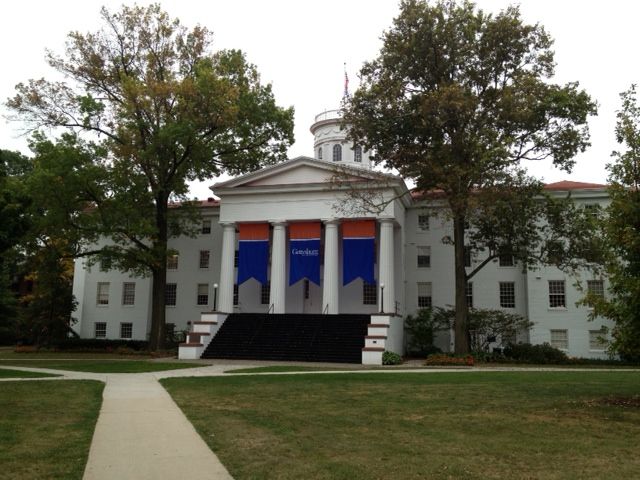
Yesterday in Part 1, the Fraternity explored the brothers that served during the Battle of Gettysburg. Today, we continue to discover our other connections to this historical town.
What other ties does Theta Chi Fraternity have to Gettysburg? It would appear that the involvement of the brothers from Alpha Chapter at the battle was only the beginning.
The Pennsylvania College of Gettysburg, the oldest Lutheran college in America, was granted its charter on April 7, 1832. Fraternities have long been a part of the college. Phi Kappa Psi, became its first national fraternity, installed as the Pennsylvania Epsilon Chapter in 1855 and was soon joined by Phi Gamma Delta in 1858 and then by Sigma Chi in 1863, just a few months prior to the battle. During the battle, many students and faculty evacuated, while others remained hidden in their homes. The campus was overun by both armies and many buildings were used as makeshift hospitals.
Many other national groups installed chapters throughout the 1880s. A total of eleven chapters were represented at Gettysburg College when three students met on the night of October 4, 1950 with the intention of bringing a new social fraternity on campus to meet the needs of the College’s increased enrollment. The "Star and Crescent Club" began recruiting members and created a new goal of forming a local fraternity that would pursue affiliation with a strong national. A motto and badge were adopted, and the group chose a new name, Alpha Theta Chi. Official correspondence began with Theta Chi Fraternity in spring 1951.

The local fraternity continued to gain members and managed to acquire a house on 339 Carlisle Street, just across from Stevens Hall, the fourth oldest building on the campus. Due to Alpha Theta Chi’s rapid progress, the Grand Chapter also acted quickly and installed Delta Omicron Chapter on March 8, 1952. The installation ceremonies were held that afternoon in the auditorium of Weidensall Hall on campus. An installation banquet was held later that evening at the Gettysburg Hotel, down the street from campus on Lincoln Square.
Regarding Delta Omicron’s installation, the April 1952 issue of The Rattle reported "At the banquet, William Goodling, President of Alpha Psi Chapter of the University of Maryland, led the group in singing." A little over 22 years later, Bill Goodling was elected to the United States Congress as the Representative for Pennsylvania’s 19th Congressional District, which contained the Borough of Gettysburg. Goodling had won election to the seat which had previously been held by his father, and held it for 26 years. In 1995 he served as Chairman of what is now called the United States House Committee on Education and Labor. In 2001, Goodling retired from public service and focused his efforts on the Goodling Institute for Research in Family Literacy.
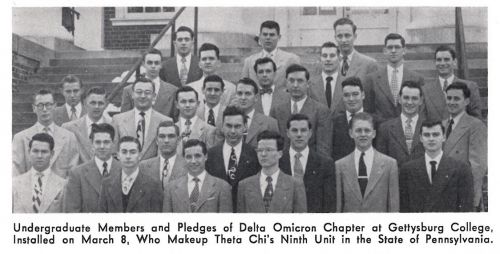
About a decade after the installation of Delta Omicron Chapter, another installation occurred on campus when Dr. Carl Arnold Hanson was formally installed as the 10th President of Gettysburg College on April 28, 1962. Dr. Hanson served as President of the College from 1961-1977. An Ohio native, Dr. Hanson had attended the University of Akron and joined Chi Theta Tau, a local fraternity that had been founded by nine Akron undergraduates on January 24, 1921. Following Hanson’s graduation in 1939, he found work at the University of Akron as Assistant Adviser of Men and later as the Assistant to the Director of Adult Education.
On February 21, 1942, Chi Theta Tau was formally installed as Theta Chi Fraternity’s Beta Lambda Chapter on Akron’s campus. Fifty-nine Chi Theta Tau alumni were initiated with 34 undergraduates including Assistant Director C. Arnold Hanson. The April-May 1942 edition of The Rattle mentions that Hanson spoke at Beta Lambda’s installation banquet noting "the satisfaction felt by all the alumni and actives over the transition from a local organization to a link in a nation-wide chain of progressive chapters."
Shortly after Beta Lambda’s installation, Hanson left to pursue graduate studies at the University of Chicago, though they were interrupted because of his service in the U.S. Navy during World War II. From 1948 to 1961 he was a professor at Cornell University's School of Industrial and Labor Relations where he earned his Ph.D., and in 1957 took on additional responsibilities as Dean of the university's college of arts and sciences. He assumed the duties as President of Gettysburg College on September 1, 1961.
Per records found at the College, under Dr. Hanson’s leadership, Gettysburg College developed the first written set of personnel policies, brought about term chairmanship for academic departments and established a five-year term for the Dean of the College. He encouraged faculty and students to work together, propose, undertake and evaluate studies aimed at helping students to be more responsible for their own learning experience, a philosophy he espoused throughout his tenure. He retired in 1977 after experiencing a series of health problems.
The Delta Omicron Chapter was active on the campus of Gettysburg College from 1952-2002 and initiated over 650 members. One of its initiates extended an Assisting Hand for decades in service to the chapter, the College, and the local community. Bruce Bugbee accepted a teaching position in the history department at Gettysburg College in
1958. He would earn his Ph.d from the University of Michigan in 1961. Dr. Bugbee specialized in Colonial and Revolutionary America, but also had a broad knowledge of the Civil War. The brothers of Delta Omicron Chapter paid attention to Dr. Bugbee and developed a friendship, recruiting him to serve as their faculty adviser. The friendship became permanent when Delta Omicron initiated Dr. Bugbee into Theta Chi Fraternity in 1969.
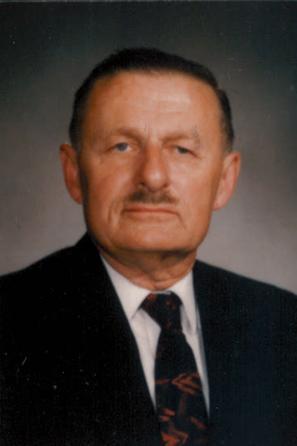
Dr. Bugbee maintained involvement with students by serving as adviser for many other student organizations including, Student Life Council, International Relations Club, Alpha Phi Omega, the Civil War Club, and the student newspaper, The Gettysburgian. He also maintained ties with the local Gettysburg community. An Eagle Scout, he chaired the Black Walnut District and would attend courts of honor. He spent many Saturdays greeting busloads of boy scouts at the Battlefield Visitors Center and lecturing them on the Battle. Dr. Bugbee supported the National Park Service for three decades and was also a member of the Gettysburg Battlefield Preservation Association.
Though he retired from teaching in 1991, Dr. Bugbee remained an active alumnus adviser to Delta Omicron Chapter. Former Delta Omicron Chapter Adviser, Scott Hendriks, Delta Omicron 1993, comments, "Dr. Bugbee was a big part of my chapter life at Gettysburg and served as our faculty advisor until 1991 when he retired; however, he continued on as our alumnus advisor until his death. He was involved in most of our chapter activities and never missed a chapter meeting…he also served as a volunteer and tour guide with the National Park Service which afforded us permission to use some of the battlefield facilities. For each of my first 3 years (Fall '89 - Spring '92), Dr. Bugbee arranged for one of our philanthropies to be the National Park Service. Twice a year, we would go to Little Round Top and clear brush and clean up the areas around the 20th Maine and the Strong Vincent (83rd Pennsylvania) Memorials. It was always several hours of work while listening to the story of the bayonet charge and the courage of the 20th Maine and Col. Joshua Lawrence Chamberlain along with the bravery of Colonel Vincent who was mortally wounded and promoted to Brigadier General just before his death…To this day, 20 years later, I can honestly say that [nearly] everything I know about the Battle of Gettysburg can be attributed to Dr. Bugbee…"
Hendriks also noted, "Dr. Bugbee was always a highlight of each parent’s weekend. Delta Omicron Chapter would rent a large van and Dr. Bugbee would give a 3 - 4 hour tour of the battlefield for anyone who wanted to go. The number of repeat attendees was always a testament to the passion and the knowledge he had for the Battle of Gettysburg."
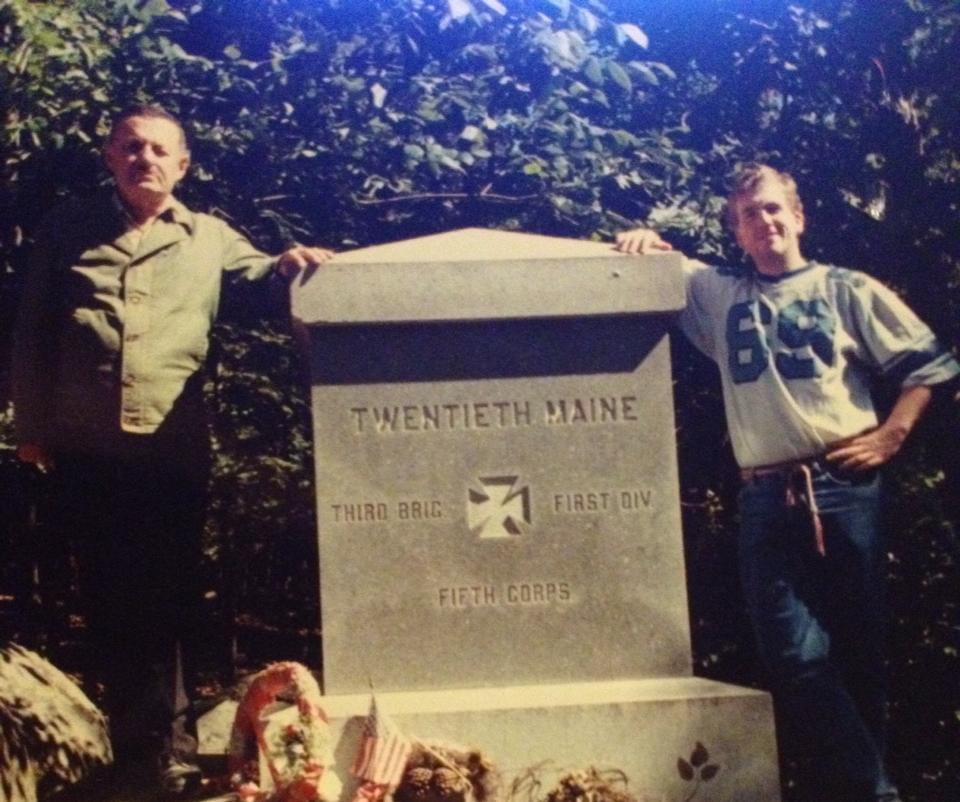
Photo shared by Paul Costenbader (Delta Omicron/Gettysburg 1991): "Dr. Bruce Bugbee and I at the 20th Maine monument in 1990. This was the portion of the battlefield we would landscape to make more historically significant."
Dr. Bugbee’s ties to the National Park Service would give Delta Omicron Chapter special access to the battlefield, and the chapter would utilize portions of it for initiation. Hendriks recalls, "For years leading up to and including my initiation year, we were permitted to conduct [part of the Ritual] inside the Pennsylvania Monument on Cemetery Ridge. It was a truly awe-inspiring event and the battlefield and monument truly lent a degree of drama that I would find hard to recreate anywhere. During my sophomore year, the Park Service changed its policy and would no longer allow us to use the monument for fear of damage, but, they did grant us permission to the use the Pitzer Woods Amphitheater on Seminary Ridge, near the Robert E. Lee (Virginia) monument, where we continued to hold [that part of the Ritual] until the chapter closed."
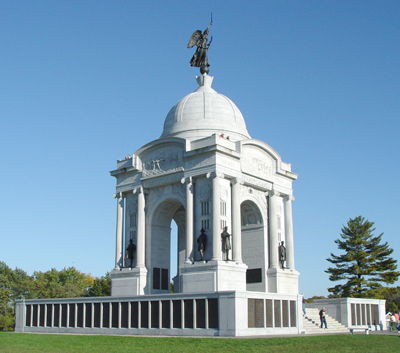
The Pennsylvania Monument, near the center of the Union line, was used by Delta Omicron Chapter for Initiation. Photo Courtesy of StoneSentinels.com / Steve Hawks
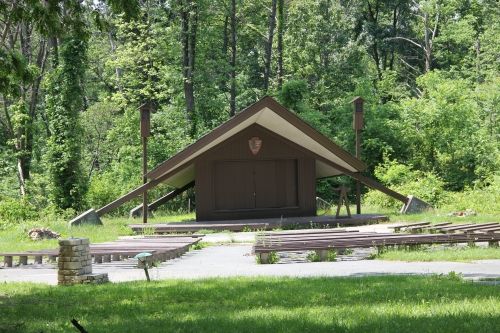
This amphitheater in Pitzer Woods near the Virginia Monument was also used by Delta Omicron Chapter.
Sadly, Dr. Bugbee passed away in July 1994. He had served on the faculty for 33 years and had served the Fraternity for over two decades. The members and alumni honored Dr. Bugbee by hanging a portrait in the chapter house, and included his picture on subsequent composites after his death. Dr. Bugbee’s final resting place would be another honor due to a man that had spent a life in service to others and also in service to country. He had enlisted in the U.S. Navy in 1945 during World War II and rose to the rank of Commander in the Naval Reserve. He remained active and was aboard the Navy guided missile cruiser USS Gridley for exercises in July 1981. The following month, he served as a member of the Intelligence Staff, Precommissioning Unit, for the Navy nuclear aircraft carrier USS Carl Vinson - - the only reservist to be called in this capacity. Though retired, he volunteered to serve as late as 1991 during the Persian Gulf War. Because of his service to country, he was interred in a special section of Gettysburg National Cemetery. Between 1898 and 1968, the National Park Service added sections to the cemetery to accommodate the graves of veterans from the Spanish-American War, World Wars I and II, the Korean War, and the Vietnam War. Dr. Bugbee’s final resting place is located in an annex just north of the Solidiers’ National Cemetery where President Abraham Lincoln delivered the Gettysburg Address on November 19, 1863.
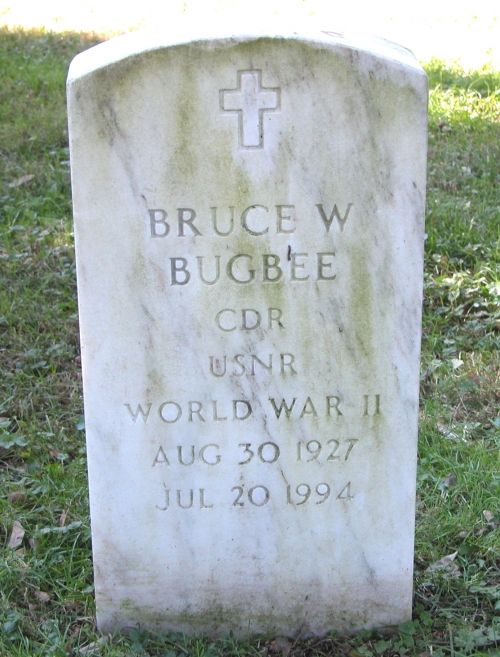
Though the chapter went inactive in 2002, Delta Omicron alumni continue to remain in touch with each other. The Spring 2012 edition of The Rattle reported a story in which several members came together to honor one of their brothers that had recently passed away. Nearly 20 brothers made a gift in their brother’s name.
A decade after the chapter closed, the Delta Omicron Alumni Association made the difficult decision to gift the chapter house to Gettysburg College. The Association also made the generous decision to donate their more than $80,000 in savings to The Foundation Chapter of Theta Chi to help fund education for future members of the Fraternity. You can read more about this story in the Summer 2013 edition of The Rattle.
On September 28, 2013, more than 100 Delta Omicron alumni gathered for a reunion at Gettysburg College to dedicate their former chapter house at 339 Carlisle Street. Gettysburg College invested over $2 million in renovations to turn the structure into impressive teaching, lab and office space for the Economics and Africana Studies departments. You can read more about the dedication ceremony in the Winter 2014 edition of The Rattle.
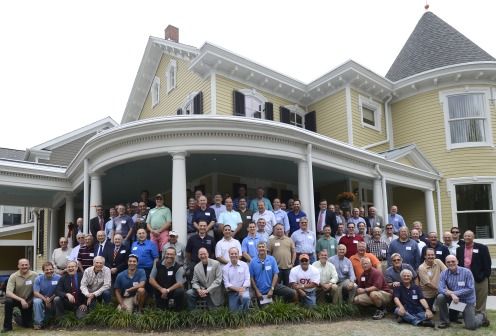
More than 100 Delta Omicron Brothers gathered for the dedication of the former chapter house.
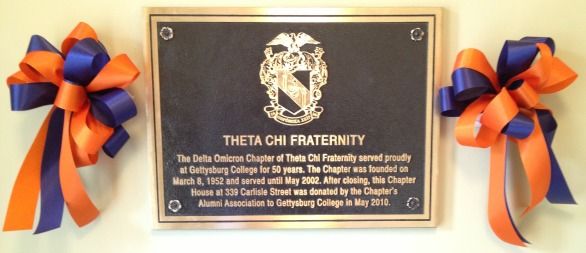
Plaque installed in the entryway of the former chapter house.
The Theta Chi spirit cultivated more than 60 years ago on campus and at 339 Carlisle Street, and later perpetuated by Dr. Bruce W. Bugbee, truly remains with the members of Delta Omicron Chapter.
Do Theta Chi’s ties to Gettysburg end with Delta Omicron or is there still more? Find out tomorrow in Part 3 and the Conclusion of "Hallowed Ground: Gettysburg’s Theta Chi Connection".



